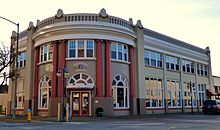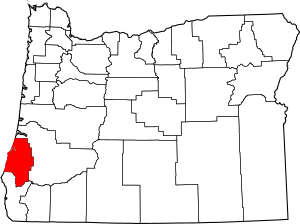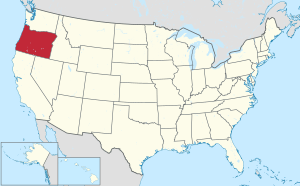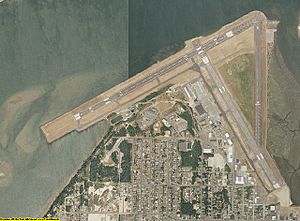Coos County, Oregon facts for kids
Quick facts for kids
Coos County
|
|
|---|---|

|
|

Location within the U.S. state of Oregon
|
|
 Oregon's location within the U.S. |
|
| Country | |
| State | |
| Founded | December 22, 1853 |
| Named for | Coos people |
| Seat | Coquille |
| Largest city | Coos Bay |
| Area | |
| • Total | 1,806 sq mi (4,680 km2) |
| • Land | 1,596 sq mi (4,130 km2) |
| • Water | 210 sq mi (500 km2) 12% |
| Population
(2020)
|
|
| • Total | 64,929 |
| • Estimate
(2023)
|
64,212 |
| • Density | 35.952/sq mi (13.881/km2) |
| Time zone | UTC−8 (Pacific) |
| • Summer (DST) | UTC−7 (PDT) |
| Congressional district | 4th |
Coos County (/kuːs/ kooss) is one of the 36 counties in the U.S. state of Oregon. As of the 2020 census, the population was 64,929. The county seat is Coquille. The county was formed from the western parts of Umpqua and Jackson counties. It is named after a tribe of Native Americans who live in the region. Coos County comprises the Coos Bay, OR Micropolitan Statistical Area.
Contents
History
Coos Bay is the homeland of two bands of Native people, Miluk and Hanis. Both today are often referred to as "Coos". Lewis and Clark noted Cook-koo-oose for Coos Bay people. The origin of the name "Coos" is probably influenced both by the Lewis and Clark reference and the name for the region in the Hanis and Miluk languages, kuukwis. Early maps and documents spelled it Kowes, Cowes, Coose, Koos, among others.
Although exploration and trapping in the area occurred as early as 1828, the first European-American settlement was established at Empire City in 1853 by members of the Coos Bay Company; this is now part of the city of Coos Bay.
Coos County was created by the Territorial Legislature from parts of Umpqua, and Jackson counties on December 22, 1853. Curry County, Oregon, was created from the southern part in 1855. The county seat was originally at Empire City. In 1895 the legislature permitted the citizens of the county to choose a new county seat. The 1896 vote resulted in moving the seat to Coquille.
The Territorial Legislature granted permission for the development of wagon roads from Coos Bay to Jacksonville, Oregon, in 1854, and to Roseburg, Oregon, in 1857.
Geography
According to the United States Census Bureau, the county has a total area of 1,806 square miles (4,680 km2), of which 1,596 square miles (4,130 km2) is land and 210 square miles (540 km2) (12%) is water.
Adjacent counties
- Douglas County - north and east
- Curry County - south
National protected areas
- Bandon Marsh National Wildlife Refuge
- Oregon Islands National Wildlife Refuge (part)
- Siskiyou National Forest (part)
- Siuslaw National Forest (part)
Demographics
| Historical population | |||
|---|---|---|---|
| Census | Pop. | %± | |
| 1860 | 445 | — | |
| 1870 | 1,644 | 269.4% | |
| 1880 | 4,834 | 194.0% | |
| 1890 | 8,874 | 83.6% | |
| 1900 | 10,324 | 16.3% | |
| 1910 | 17,959 | 74.0% | |
| 1920 | 22,257 | 23.9% | |
| 1930 | 28,373 | 27.5% | |
| 1940 | 32,466 | 14.4% | |
| 1950 | 42,265 | 30.2% | |
| 1960 | 54,955 | 30.0% | |
| 1970 | 56,515 | 2.8% | |
| 1980 | 64,047 | 13.3% | |
| 1990 | 60,273 | −5.9% | |
| 2000 | 62,779 | 4.2% | |
| 2010 | 63,043 | 0.4% | |
| 2020 | 64,929 | 3.0% | |
| 2023 (est.) | 64,212 | 1.9% | |
| U.S. Decennial Census 1790–1960 1900–1990 1990–2000 2010–2020 |
|||
2010 census
As of the 2010 census, there were 63,043 people, 27,133 households, and 16,857 families living in the county. The population density was 39.5 inhabitants per square mile (15.3/km2). There were 30,593 housing units at an average density of 19.2 units per square mile (7.4 units/km2). The racial makeup of the county was 89.8% white, 2.5% Native American, 1.0% Asian, 0.4% black or African American, 0.2% Pacific islander, 1.7% from other races, and 4.3% from two or more races. Those of Hispanic or Latino origin made up 5.4% of the population. In terms of ancestry, 22.9% were German, 15.0% were English, 12.7% were Irish, 7.4% were American, and 5.2% were Scottish.
Of the 27,133 households, 24.2% had children under the age of 18 living with them, 47.2% were married couples living together, 10.2% had a female householder with no husband present, 37.9% were non-families, and 29.8% of all households were made up of individuals. The average household size was 2.29 and the average family size was 2.78. The median age was 47.3 years.
The median income for a household in the county was $37,491 and the median income for a family was $46,569. Males had a median income of $39,744 versus $28,328 for females. The per capita income for the county was $21,981. About 11.5% of families and 16.4% of the population were below the poverty line, including 21.4% of those under age 18 and 8.1% of those age 65 or over.
Communities
Cities
- Bandon
- Coos Bay
- Coquille (county seat)
- Lakeside
- Myrtle Point
- North Bend
- Powers
Census-designated places
- Barview
- Bunker Hill
- Glasgow
- Saunders Lake
Other unincorporated communities
Economy

Deposits of gold initially attracted people to the county in the nineteenth century. Between 1890 and 1910, large amounts of coal were mined in the county and shipped to California; production decreased after oil was discovered in that state, and no coal mines in the county have been in production since 1950. These coal fields have been explored for natural gas since 1938, although CDX Gas, a company based in Texas announced in 2003 that they would be drilling two test wells later that year.
A project to build a 60-mile (97 km) natural gas pipeline between the cities of Roseburg and Coos Bay, which would attract new industry to the Coos Bay area, was begun in 1999 when voters approved a local bond measure to raise as much as $27 million, with the state of Oregon providing $24 million. The pipeline construction began in June 2003 and was finished in 2004.
Currently, forest products, tourism, fishing and agriculture dominate the Coos County economy. The service industry is replacing the former lumber-driven economy. Bandon Dunes Golf Resort, north of Bandon and south of Coos Bay, attracts tourists and golfers from around the world. Boating, dairy farming, myrtlewood manufacturing, shipbuilding and repair and agriculture specialty products, including cranberries, also play an important role. Untapped rich deposits of iron ore and lead await development.
The Jordan Cove Energy Project is a project that was met with resistance since 2010 by farm owners and other land owners, tribal natives, and some commercial entities who did not want their land being used or taken without their permission, with eminent domain. The project was cancelled in late 2021.
A current project underway in Coos County, undertaken by Oregon Resources Corporation (ORC), uses modern strip-mining techniques to extract chromite, zircon, and garnet from local sands. The tailings after processing will be returned and re-contoured to replicate pre-mining conditions, and the affected area will be reforested. Job numbers are not listed on the company website but an annual payroll of $3.5 million is listed in the economic impact portion of the FAQ. The Oregon League of Women Voters cited similar numbers from ORC, wholly owned by Industrial Mineral Corporation of Australia; the operation was projected to create 70 to 80 jobs with a salary of $46,000 per year. Efforts to block the project because of health and environmental concerns did not succeed.
There are several port districts in the county: Port of Coos Bay founded in 1909, Port of Coquille River founded in 1912, and Port of Bandon founded in 1913. Coos Bay is considered the best natural harbor between San Francisco Bay and the Puget Sound, and the Port of Coos Bay was the largest forest products shipper in the world until late 2005 when raw log exports via transport ship were suspended.
Natural history
The tallest documented living specimen of a Douglas-fir tree in the world is found 35 miles (56 km) southeast of Coos Bay in the Sitkum area and is slightly more than 100 metres (330 ft) tall.
See also
 In Spanish: Condado de Coos para niños
In Spanish: Condado de Coos para niños

